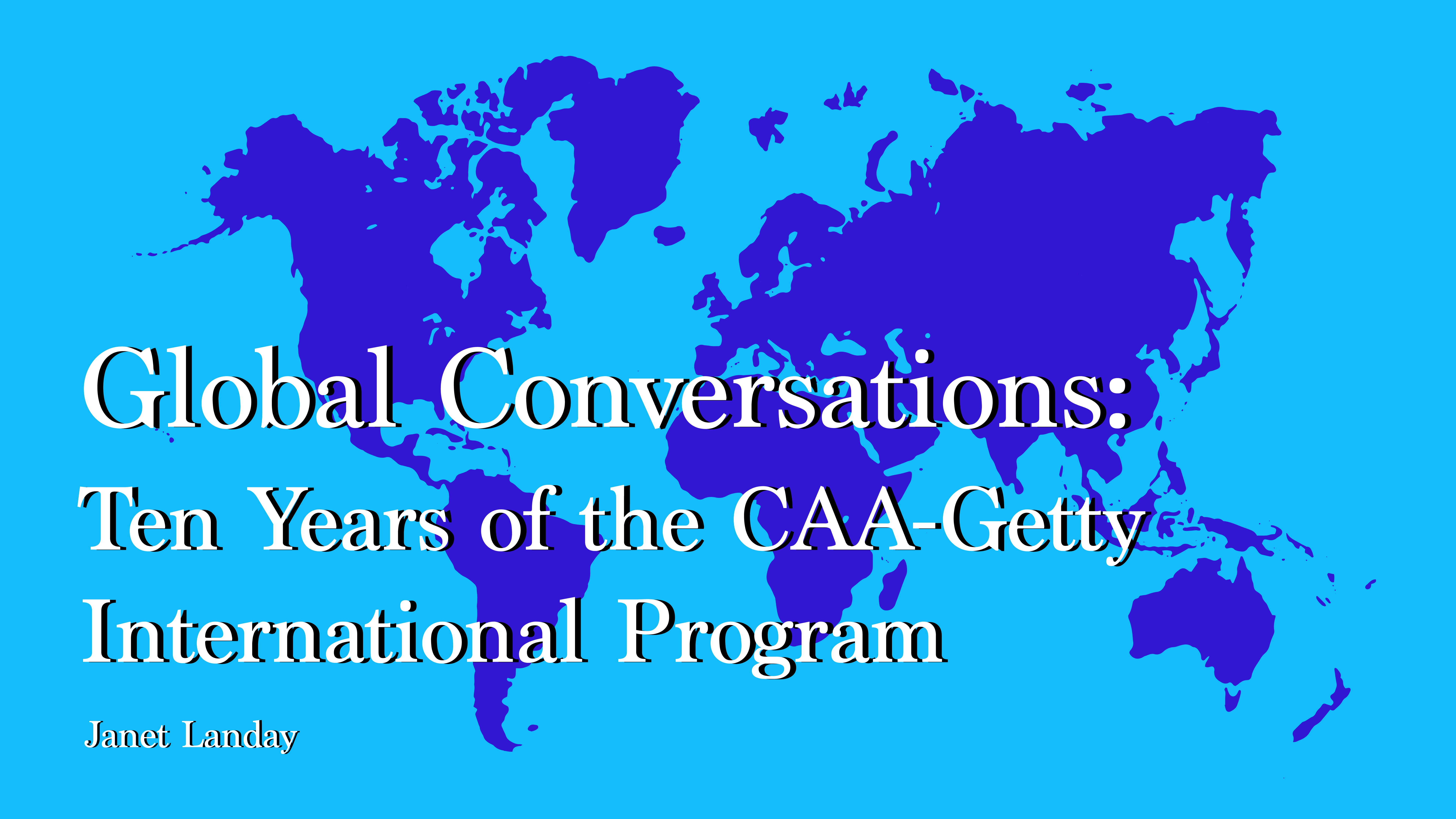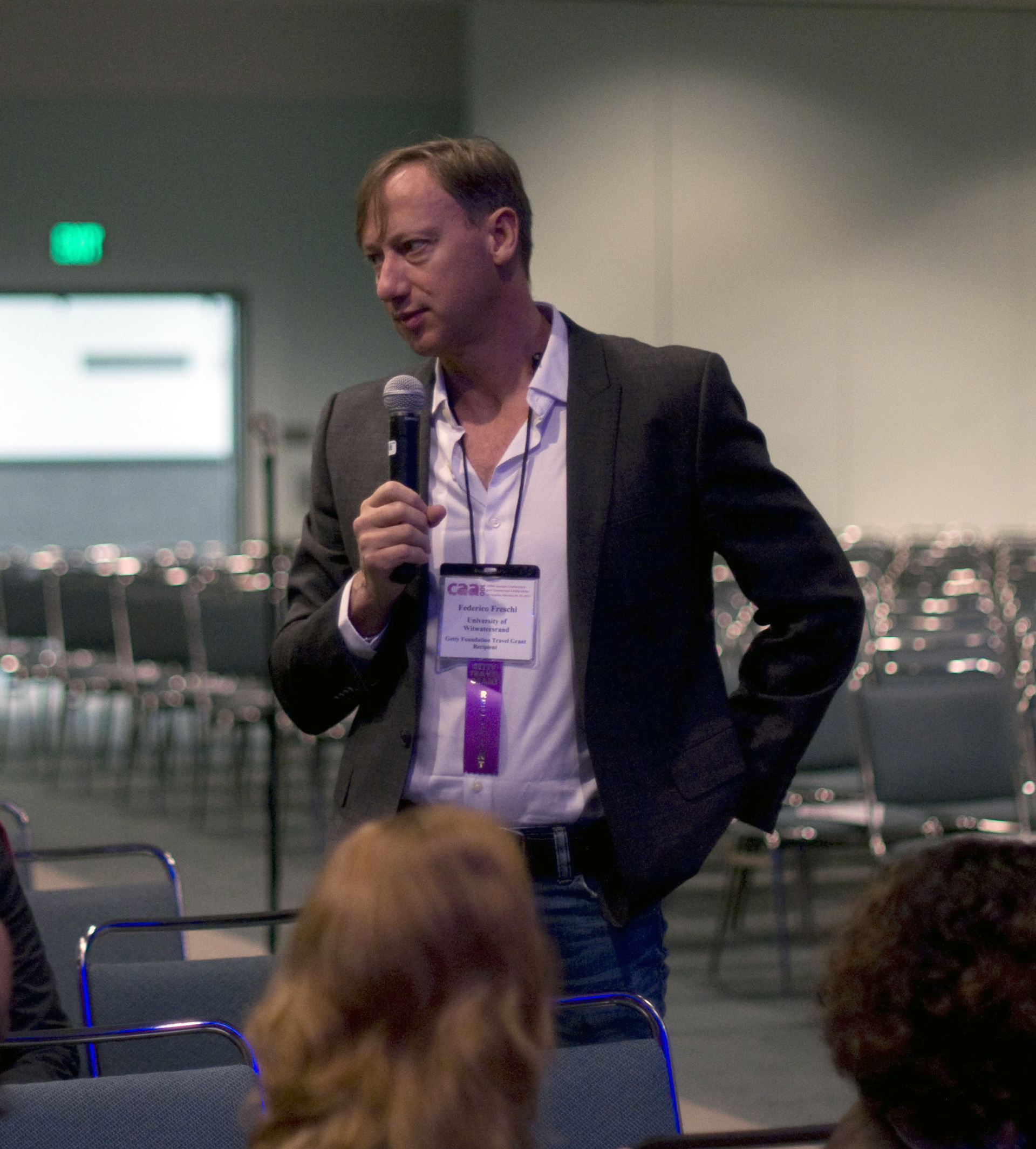Annotated Timeline
|
2011
| |
|
2012
|
Federico Freschi, from South Africa, speaks at a meeting of the first gathering of the CAA-Getty International Program.
Meeting different colleagues from all over the world was a great experience. . . . I learned how possible and great it is to work with others although we have different research fields. I am convinced that it is very important to work in collaboration with other researchers. —Didier Houenoude (Benin)
When I participated in the first year of the CAA-Getty International Program, I was able to meet researchers from many countries other than mine, with different cultural and institutional contexts. The discussions we had throughout the week were deeply enriching. Brazil is a large country, but very isolated, including by language, since we speak Portuguese and not Spanish, as in the rest of Latin America. I therefore didn’t know anything about the lives of researchers and historians from Asia, Eastern Europe, Africa, and even other parts of South America. —Rosa Gabriella de Castro Gonçalves (Brazil)
|
|
2013
|
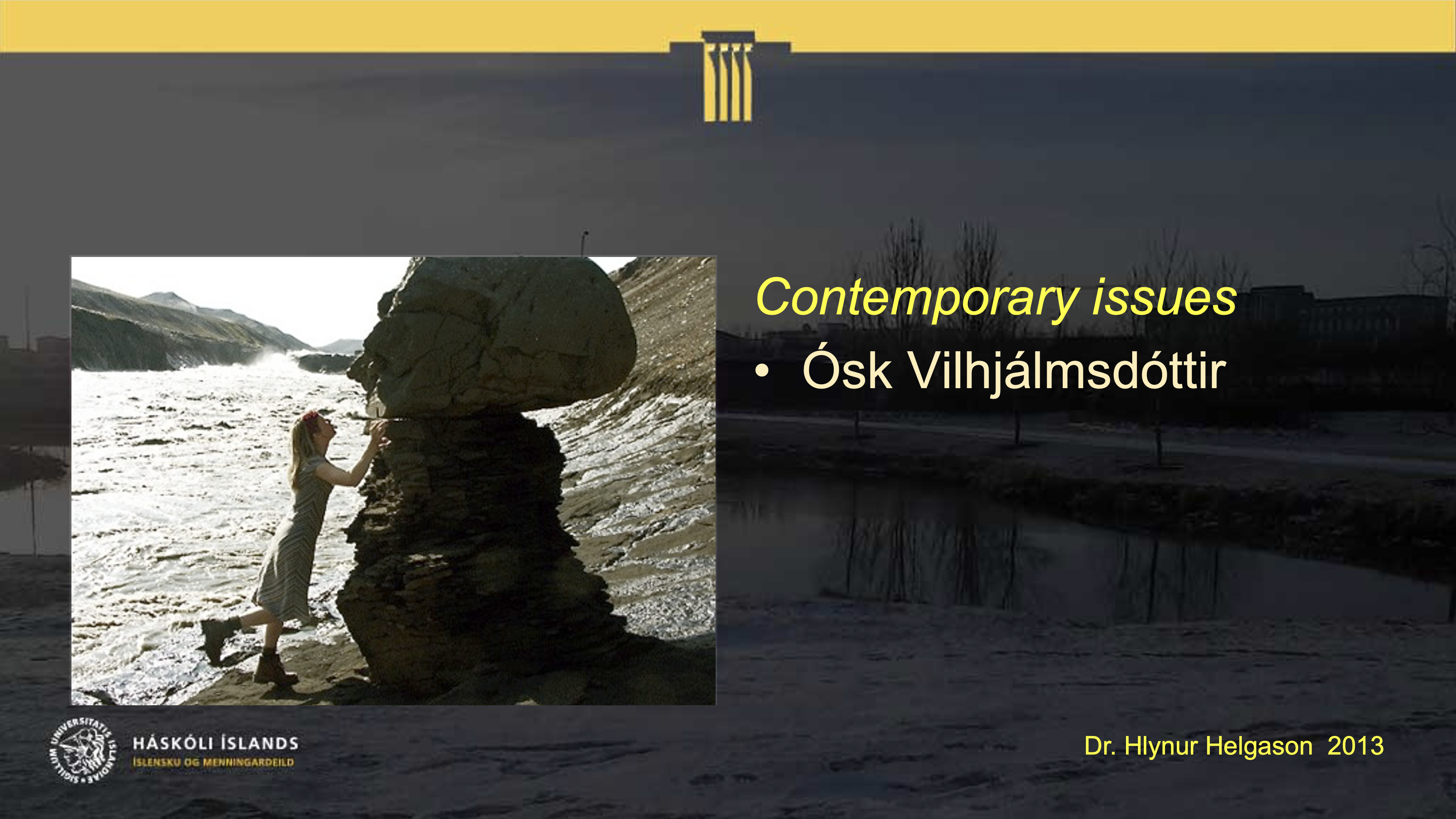 “Art Theory,” Hlynur Helgason, University of Iceland, presented at a 2013 preconference meeting of participants (photograph provided by Hlynur Helgason)
The CAA-Getty International Program is all about people. The ability to meet so many interesting people from various traditions, backgrounds, academic systems, practices, and visions: this was the best experience. . . . Through discussions with them about such things as the position, future, and purpose of art history, I have discovered different perspectives and approaches. It is especially interesting for people like me, with a very traditional Eurocentric approach to the discipline of art history, to exchange ideas with scholars from around the world. —Marina Vicelja-Matijasic (Croatia)
My participation in the CAA-Getty International Program has intensified my interest in the impact of globalization on the discipline of art history. What seemed to be a solitary interest in a burgeoning field turned out to be a common concern cutting across nationalities and even races. —Parul Dave Mukherji (India)
|
|
2014
|
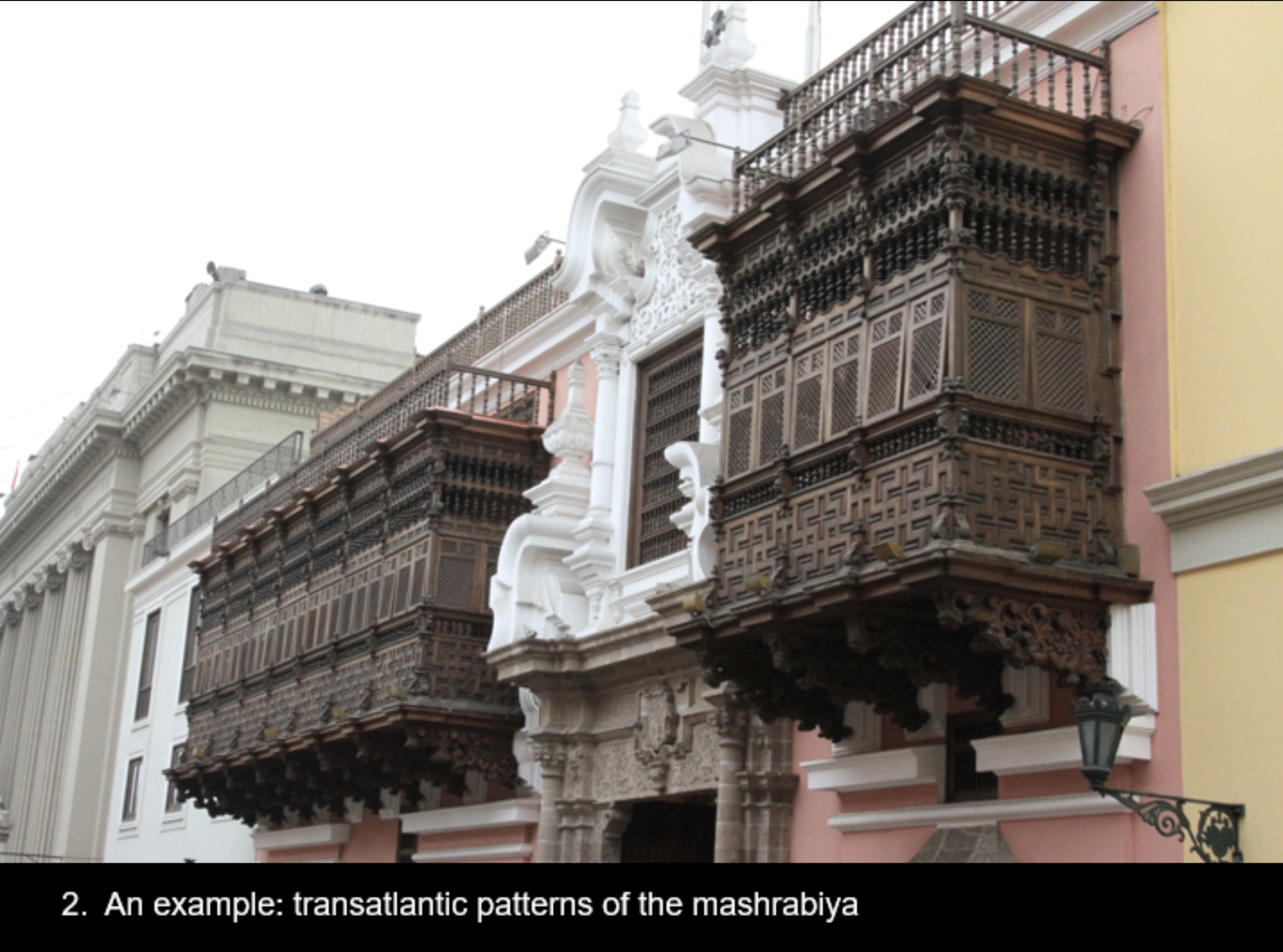 “Islamic and Latin American Countries, Transcultural Connections,” Fernando Luis Martínez Nespral, School of Architecture, Design, and Urbanism, University of Buenos Aires, Argentina, presented at the 2014 preconference colloquium (photograph provided by Fernando Luis Martínez Nespral)
The preconference shows how the phenomenon of globalization has created a new art world in which cultures are no longer distant from one another, people and places are no longer as separate as they once were. . . . The real satisfaction of this event was hybridity, or the mixing of the traditions of different cultures to create new blends and new connections. —Hugues Heuman Tchana (Cameroon)
Thanks to two CAA-Getty travel grants (2014 and 2017), I was privileged to experience what I consider to be one of the most exciting global events in transforming the world of art history, theory, and practice. Perhaps the most enticing element of these experiences is the acknowledgment of methodological and thematic changes in the new art history and the awareness of the need to introduce these changes into my research and teaching. . . . Finally, and perhaps most importantly, being part of these CAA programs in times of political, social, and cultural turmoil in the US reassured me of the crucial significance and even therapeutic potential of humanistic scholarship for societies in crisis. —Laris Borić (Croatia)
|
|
2015
|
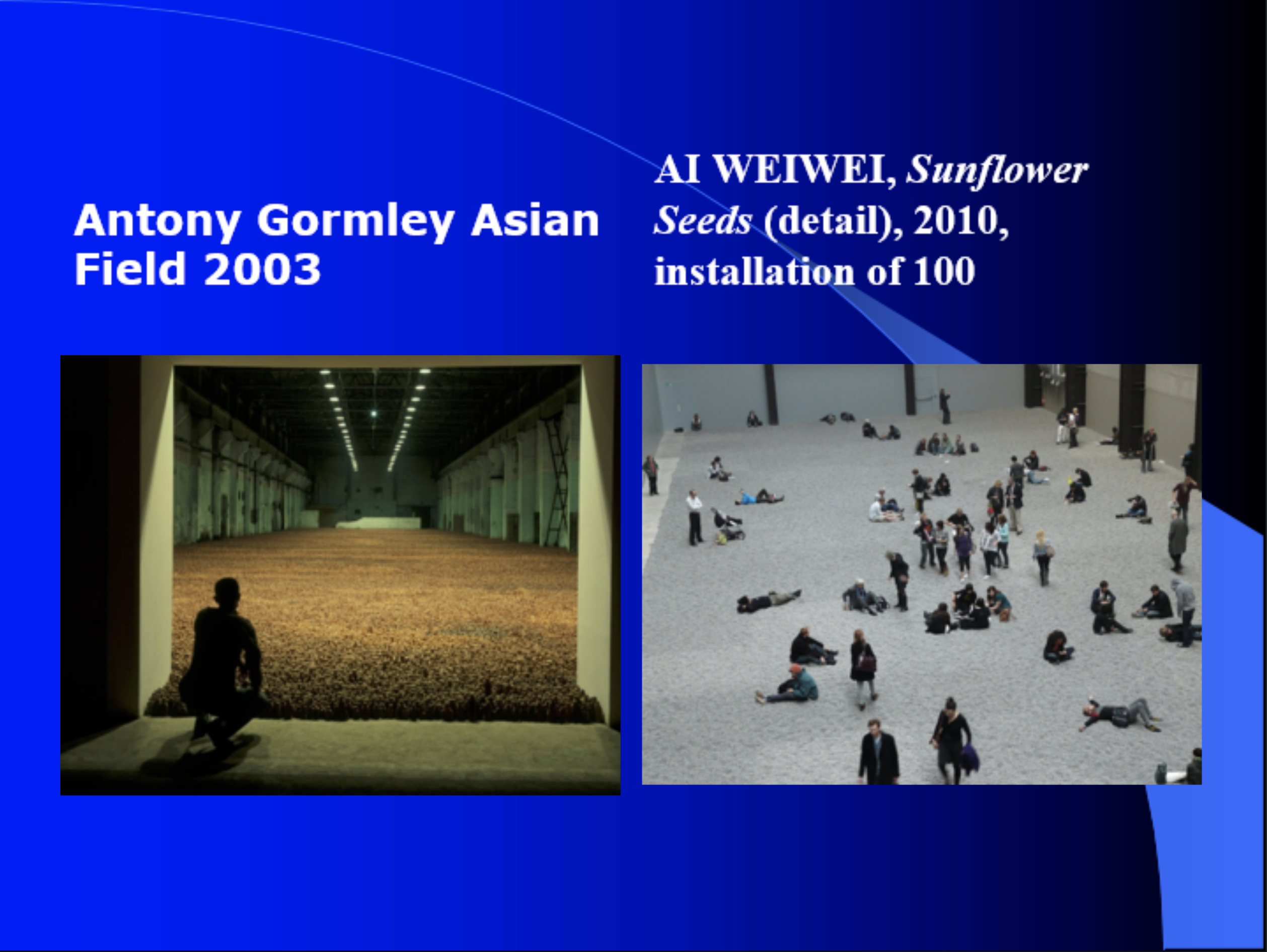 “Infinite Social Landscape: The Transformative Moments of Chinese Contemporary Art on the Global Stage,” Shao Yiyang, School of Humanities, Central Academy of Fine Art, China, presented at the 2015 preconference colloquium (slide photograph provided by Shao Yiyang). The slide includes photographs of installations by Anthony Gormley (2003) and Ai Weiwei (2010) (artworks © Anthony Gormley and © Ai Weiwei, both published under fair use).
The topics were as diverse as the participants themselves, but the questions that lay at the heart of the papers were closely related. All the participants were interested in the questions of the “internationalization” of art history, and it was a wonderful experience to be able to discuss these issues with colleagues from all over the world. —Nóra Veszprémi (Hungary/UK)
When I joined the other CAA-Getty international scholars in February 2015 at the preconference discussion and, over the next few days, dove into the multitude of sessions and events at the CAA Annual Conference, the reality surpassed all my expectations. My professional network, which until then included scholars mostly from Eastern and some from Western Europe, expanded exponentially to global dimensions. I found myself in exchanges and discussions with scholars from Africa, Asia, and South and North America. All this was revealing and highly thought-provoking. The door in the post-Soviet/Euro “room” in which I had spent my previous scholarly life was opened, and I discovered multiple new dimensions just across the threshold. I stepped through the entrance then and have keep moving forward. . . . These global connections are horizontal rather than hierarchical, situational rather than permanent, fragile rather than robust; but they are crucial for overcoming the present crisis of fragmentation that we are experiencing both locally and globally. . . . The commonality and solidarity that I experience in the CAA-Getty community allows me to envision a better future for our discipline. —Nazar Kozak (Ukraine)
|
|
2016
|
 “Early Modern Architecture: Regional Approach vs. National History,” Lev Maciel, National Research University, Higher School of Economics, Moscow, Russia, presented at the 2016 preconference colloquium (photograph provided by Lev Maciel).
The [EESA] roundtable offered me an absolutely new perspective to study and understand the contemporary artistic movements in Eastern Europe. . . . I hadn’t realized the hard intention of art historians to get free from the permanent comparison to European developments. —Ildikó Gericsné Fehér (Hungary)
For me, the CAA-Getty International Program has had a significant impact on my career and life. The program provided me an opportunity for broader discussions around methodologies and approaches to building a rich, sophisticated, cross-regional and archival history of international art history. Participating in the project helped me better understand Vietnamese art in the context of world art, strengthen my research, and improve my lectures and writing on Vietnamese art. —Bùi Thị Thanh Mai (Vietnam)
|
|
2017
|
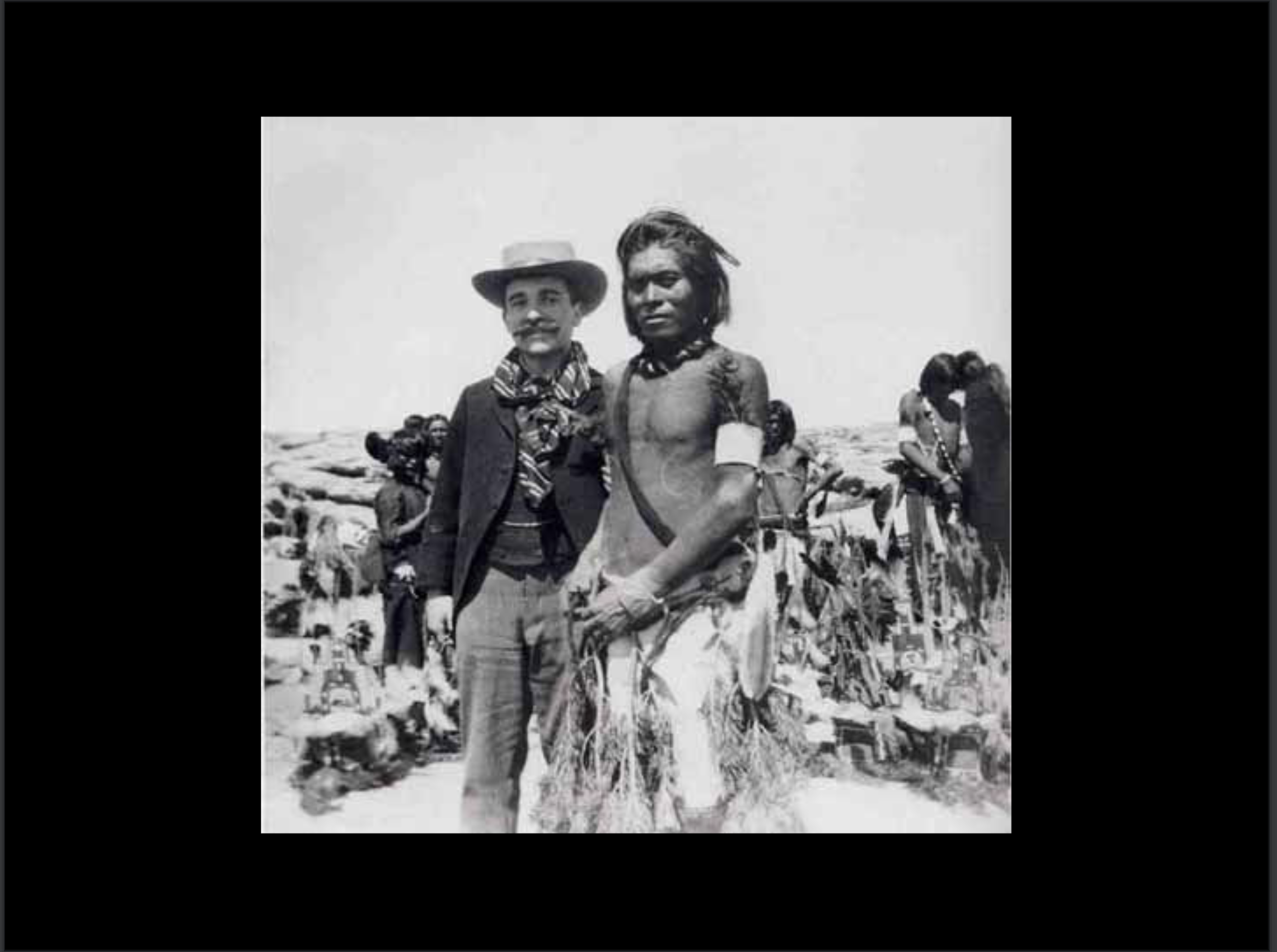 “Aby Warburg and the Boundaries of Art History,” Rosa Gabriella de Castro Gonçalves, Universidade Federal da Bahia, Brazil, presented at a 2017 Global Conversations reunion session (slide photograph provided by Rosa Gabriella de Castro Gonçalves). The slide includes a photograph, “Aby Warburg with an unidentified Hopi dancer, Arizona, May 1896” (photograph in the public domain, provided by Warburg Institute Archive, London).
The Global Conversations sessions at the conference in New York were particularly beneficial to me due to the extensive debates on important issues such as educational systems, university curricula, exhibition strategies, and institutional structures for art as practiced in the United States and around the world. I also learned how both American and international art historians, philosophers of culture, and museum curators view the current state of the art historical discipline, and which methodologies are considered most useful and relevant for research in the field. . . . The sustained alumni network of the CAA-Getty International Program, including the American hosts, has supported my professional development even as it stimulates transnational cooperation and research projects for the future.
I think having a reunion of past grant recipients was a fantastic idea. My re-interaction with the conference indicated clearly how my own research and academic work has flourished since 2014 in a manner that has not been made evident in other contexts. —Portia Malatjie (South Africa)
|
|
2018
|
 copy.jpg) “The Mediation of the Object: Iconographies of Travel across the Indian Ocean,” Parul Pandya Dhar, University of Delhi, presented at the 2018 Global Conversations alumni session (slide photograph provided by Parul Pandya Dhar). The slide includes works from fifth-century Ajanta, India, and ninth-century Indonesia (artworks in the public domain).
Nothing is better for creating new and valuable experiences, and for exploring and sharing ideas, than a wide discussion platform such as the CAA-Getty International Program, which helps to tie different cultures together. Besides being honored to be part of this exceptional community, the experience helped me foster a closer look at my area of specialization from a wider perspective: across spatial borders, time, media, and cross-cultural influences. —Markéta Hánová (Czech Republic)
My former professor from Poland, Piotr Piotrowski, spoke in his books and papers about a horizontal art history, a need to create a decolonial, nonhierarchical, transnational, transcultural, and inter-epistemic dialogue among scholars and within the narratives of art history. I personally believe that the CAA-Getty International Program is the best realization of this goal. The meetings that are generated by the program are based on a true exploration of ideas, conducted with respect and friendship among scholars from all over the world. The intense exchanges that result produce not only an understanding of different points of view, but also the discovery that, in spite of many differences, we are very close to each other, our art historical questions are sometimes surprisingly similar, and we support the very same ideals of scholarly collaboration without borders. —Katarzyna Cytlak (Poland, then working in Argentina)
|
|
2019
|
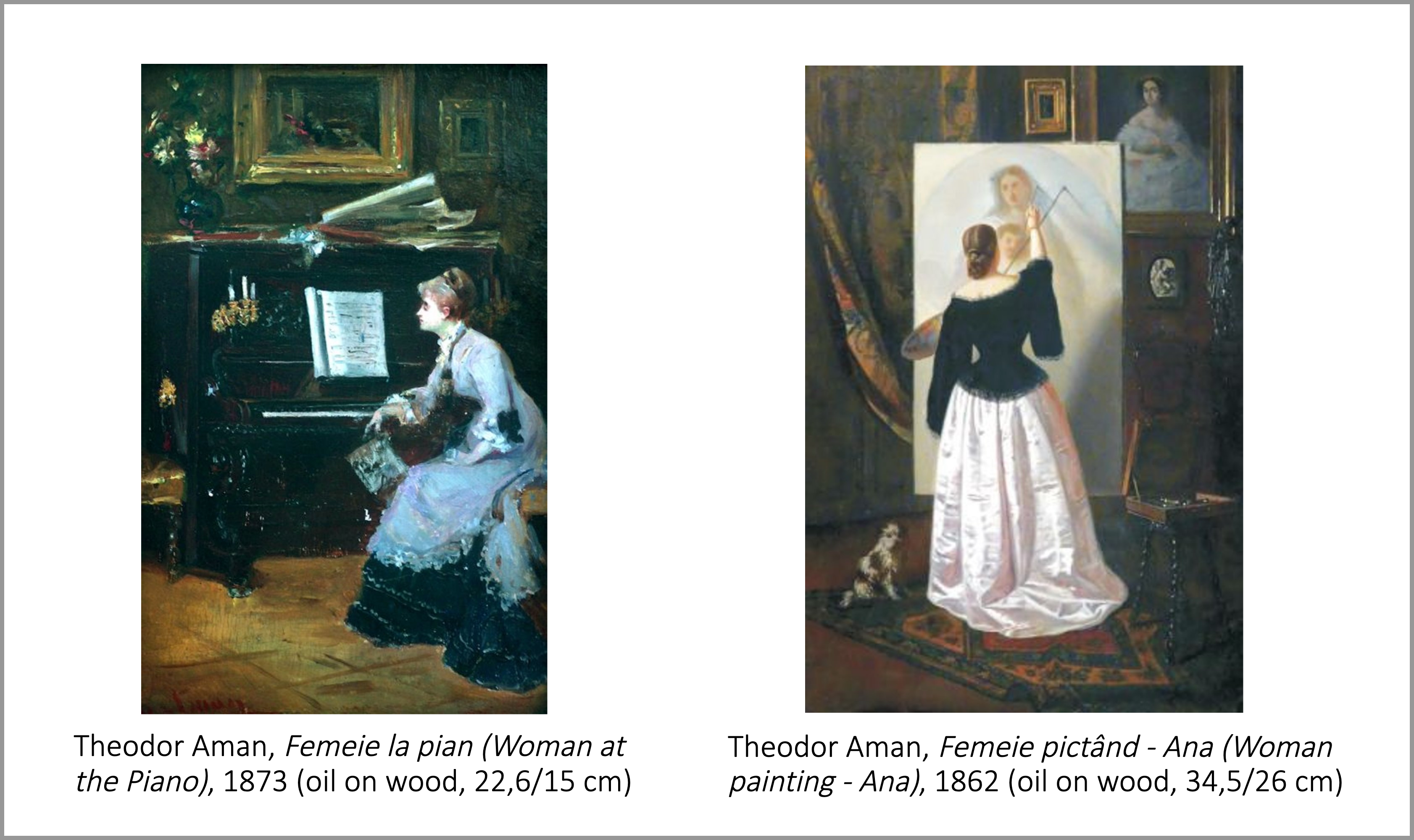 “Orientalism and Female Portraiture in Nineteenth-Century Painting in Romania,” Oana Maria Nicuță Nae, George Enescu National University of Arts, Iasi, Romania, presented at the 2019 preconference colloquium (slide photograph provided by Oana Maria Nicuță Nae). The slide includes photographs of two paintings by Theodor Aman (1873 and 1862) (artworks in the public domain).
In my academic experience, I have never ever come across a selection process which is so transparent and democratic. . . . Listening to all the preconference sessions by other participants opened up a whole new world of common issues faced by all of us on a daily basis, irrespective of the countries. But it also taught me how to overcome the challenges. —Swati Chemburkar (India)
I thought the preconference discussion was excellent. I really appreciated having THREE expert pairs of eyes look over my paper (what a treat!) and offer feedback. The discussion also made participants feel part of the program, working together towards a common goal. . . . What I liked best was the opportunity to hear a total of fifteen short well thought-through papers on subjects I would not necessarily select to attend at a conference. —Richard Bullen (New Zealand)
|
|
2020
|
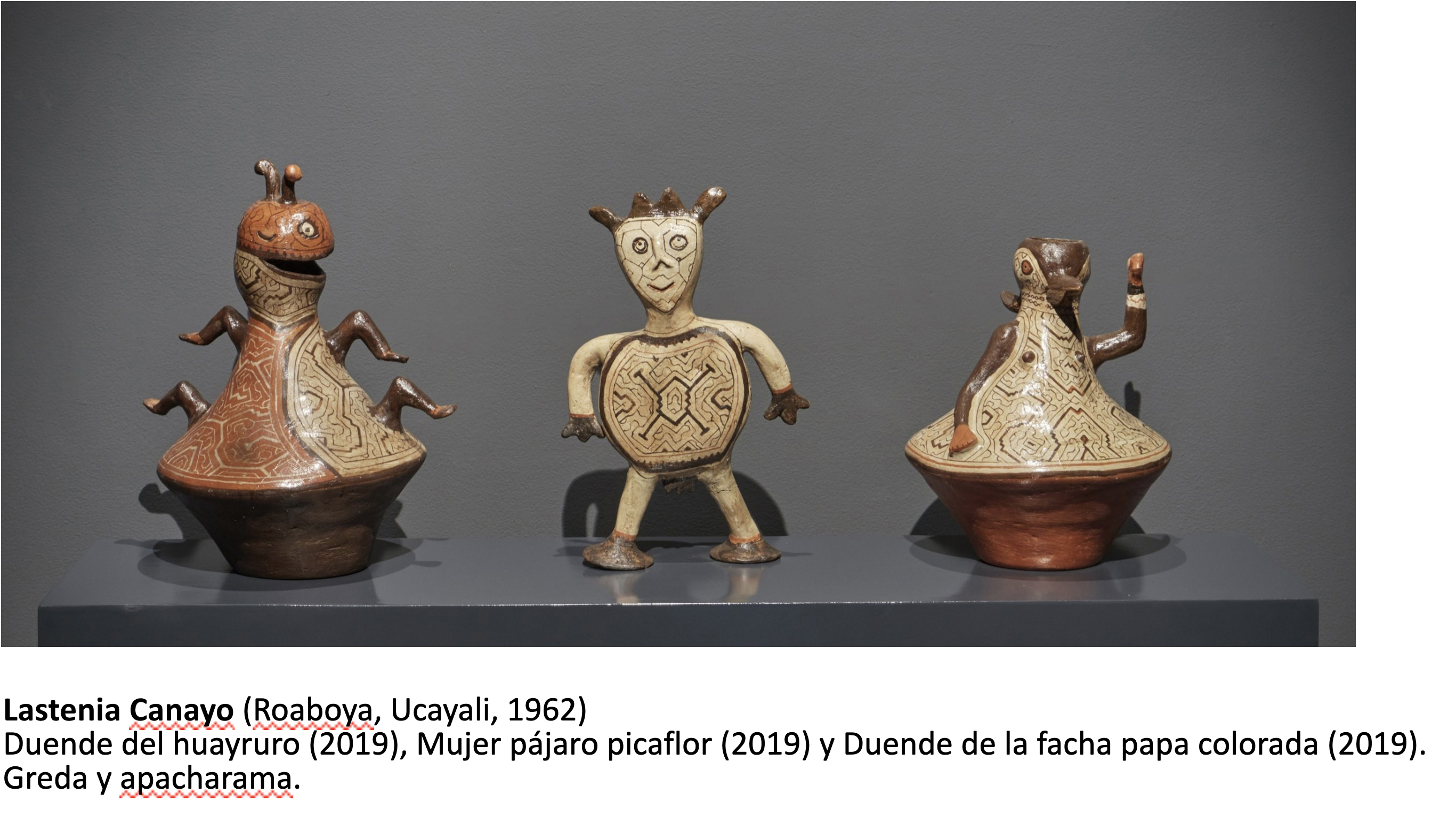 “To Give Shape to Time: Contemporary Perspectives on Prehispanic Ceramics,” Giuliana Vidarte, Museo de Arte Contemporáneo, Lima, Peru, presented at the 2020 preconference colloquium (slide photograph provided by Giuliana Vidarte). The slide includes a photograph of three 2019 works by Lastenia Canayo (artworks © Lastenia Canayo, published under fair use).
Attending the CAA conference was hugely stimulating, and I left feeling excited about the future of art history. It reminded me of the strengths of deep art historical research in providing a more complex and nuanced understanding of art and society. —Julia Waite (New Zealand)
Participating in the CAA-Getty preconference colloquium gave me many ideas on how to connect art histories between unlikely contexts. For example, I identified similar interests regarding issues of coloniality, indigenous art, and geopolitics in presentations from Nigeria, New Zealand, and South Africa. . . . I am one of not more than a handful of art historians in Bolivia, and I have almost no opportunities to exchange ideas about art, research, and education. For this reason, I cannot emphasize enough the impact that attending these meetings can have for colleagues in similar situations around the world. —Valeria Paz Moscoso (Bolivia)
|
|
2021
|
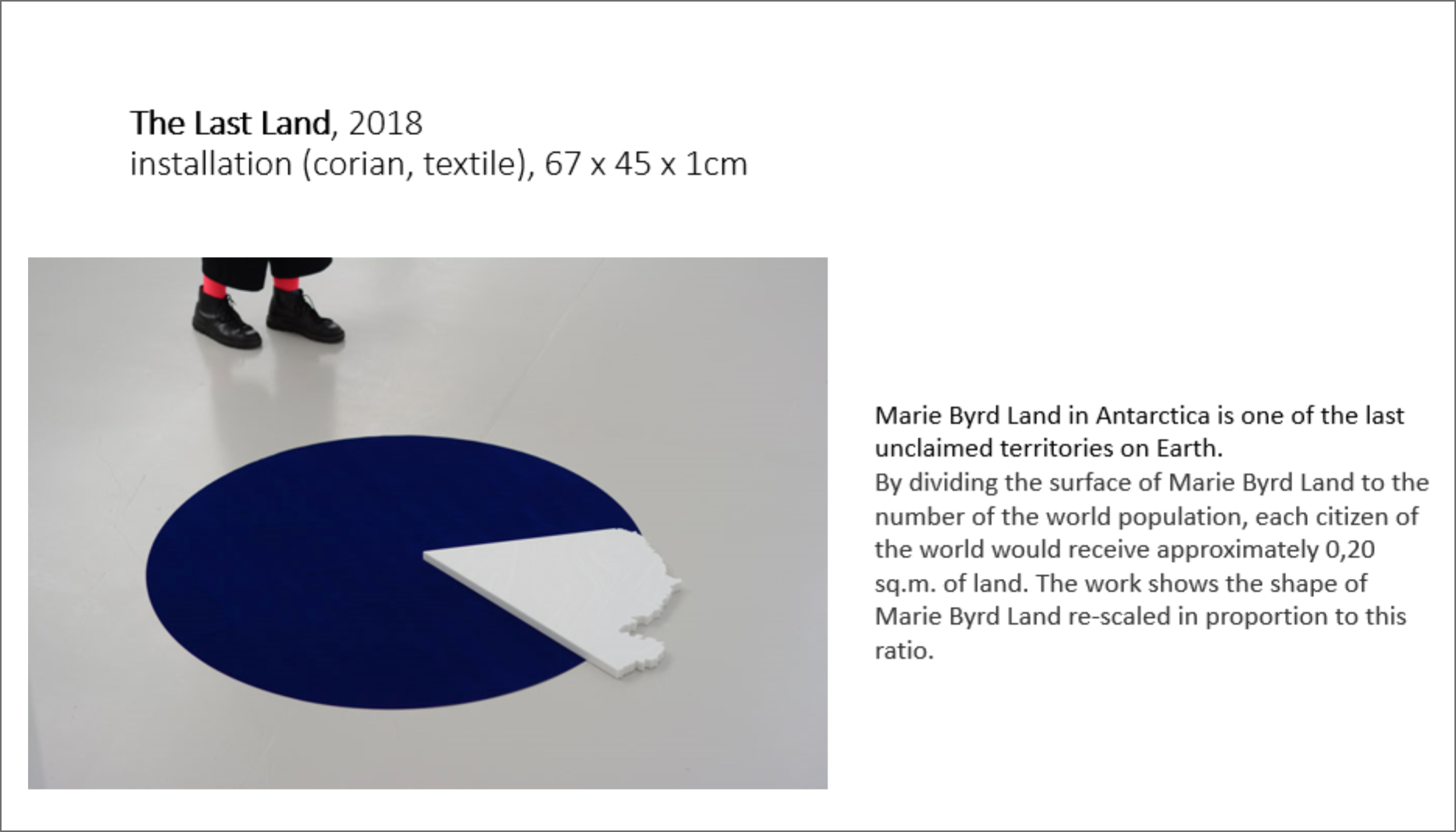 “Anthropocene and Capitalocene: Soil, Land, and Territory in the Artistic Research of Anca Benera and Arnold Estefan,” Cristian Nae, George Enescu National University of Arts, Iasi, Romania, presented at a 2021 Global Conversations session (slide photograph provided by Cristian Nae). The slide includes a photograph of an installation by Anca Benera and Arnold Estefan, The Last Land, 2018 (artwork © Anca Benera and Arnold Estefan, published under fair use).
Although Zoom meetings can't replace face-to-face meetings, the 2021 International Program was an incredibly challenging and enriching experience. One of the things I most appreciated was sharing my research with renowned scholars from all over the world and having the opportunity to discuss my ideas throughout this past year. . . . I learnt so much from all the participants. Their commitment and warmth have shone through during these uncertain and trying times. Thank you all for being an inspiring network for collective thinking and action. —Daniela Lucena (Argentina)
The great challenge for the CAA-Getty International Program now is not only to share new information and ideas about different places in the world, but also to figure out how to evaluate all the cross-cultural connections we have made over the past ten years. It's not easy to step outside the limits of our own perspectives—we could call them local databases and relationships. But our experiences of the last year show it can paradoxically be done even better than in previous years. We already know that the COVID crisis is accelerating a good deal of global awareness; this year's CAA-Getty program, which included multiple online discussions among scholars from around the world, showed how we can accelerate our global scholarly understanding. —Richard Gregor (Slovakia)
|
|
2011
2012
Federico Freschi, from South Africa, speaks at a meeting of the first gathering of the CAA-Getty International Program.
Meeting different colleagues from all over the world was a great experience. . . . I learned how possible and great it is to work with others although we have different research fields. I am convinced that it is very important to work in collaboration with other researchers. —Didier Houenoude (Benin)
When I participated in the first year of the CAA-Getty International Program, I was able to meet researchers from many countries other than mine, with different cultural and institutional contexts. The discussions we had throughout the week were deeply enriching. Brazil is a large country, but very isolated, including by language, since we speak Portuguese and not Spanish, as in the rest of Latin America. I therefore didn’t know anything about the lives of researchers and historians from Asia, Eastern Europe, Africa, and even other parts of South America. —Rosa Gabriella de Castro Gonçalves (Brazil)
|
|
|
2013
 “Art Theory,” Hlynur Helgason, University of Iceland, presented at a 2013 preconference meeting of participants (photograph provided by Hlynur Helgason)
The CAA-Getty International Program is all about people. The ability to meet so many interesting people from various traditions, backgrounds, academic systems, practices, and visions: this was the best experience. . . . Through discussions with them about such things as the position, future, and purpose of art history, I have discovered different perspectives and approaches. It is especially interesting for people like me, with a very traditional Eurocentric approach to the discipline of art history, to exchange ideas with scholars from around the world. —Marina Vicelja-Matijasic (Croatia)
My participation in the CAA-Getty International Program has intensified my interest in the impact of globalization on the discipline of art history. What seemed to be a solitary interest in a burgeoning field turned out to be a common concern cutting across nationalities and even races. —Parul Dave Mukherji (India)
2014
 "Islamic and Latin American Countries, Transcultural Connections," Fernando Luis Martínez Nespral, School of Architecture, Design, and Urbanism, University of Buenos Aires, Argentina, presented at the 2014 preconference colloquium (photograph provided by Fernando Luis Martínez Nespral)
The preconference shows how the phenomenon of globalization has created a new art world in which cultures are no longer distant from one another, people and places are no longer as separate as they once were. . . . The real satisfaction of this event was hybridity, or the mixing of the traditions of different cultures to create new blends and new connections. —Hugues Heuman Tchana (Cameroon)
Thanks to two CAA-Getty travel grants (2014 and 2017), I was privileged to experience what I consider to be one of the most exciting global events in transforming the world of art history, theory, and practice. Perhaps the most enticing element of these experiences is the acknowledgment of methodological and thematic changes in the new art history and the awareness of the need to introduce these changes into my research and teaching. . . . Finally, and perhaps most importantly, being part of these CAA programs in times of political, social, and cultural turmoil in the US reassured me of the crucial significance and even therapeutic potential of humanistic scholarship for societies in crisis. —Laris Borić (Croatia)
2015
 “Infinite Social Landscape: The Transformative Moments of Chinese Contemporary Art on the Global Stage,” Shao Yiyang, School of Humanities, Central Academy of Fine Art, China, presented at the 2015 preconference colloquium (slide photograph provided by Shao Yiyang). The slide includes photographs of installations by Anthony Gormley (2003) and Ai Weiwei (2010) (artworks © Anthony Gormley and © Ai Weiwei, both published under fair use).
The topics were as diverse as the participants themselves, but the questions that lay at the heart of the papers were closely related. All the participants were interested in the questions of the “internationalization” of art history, and it was a wonderful experience to be able to discuss these issues with colleagues from all over the world. —Nóra Veszprémi (Hungary)
When I joined the other CAA-Getty international scholars in February 2015 at the preconference discussion and, over the next few days, dove into the multitude of sessions and events at the CAA Annual Conference, the reality surpassed all my expectations. My professional network, which until then included scholars mostly from Eastern and some from Western Europe, expanded exponentially to global dimensions. I found myself in exchanges and discussions with scholars from Africa, Asia, and South and North America. All this was revealing and highly thought provoking. The door in the post-Soviet/Euro “room” in which I had spent my previous scholarly life was opened, and I discovered multiple new dimensions just across the threshold. I stepped through the entrance then and have kept moving forward. . . . These global connections are horizontal rather than hierarchical, situational rather than permanent, fragile rather than robust; but they are crucial for overcoming the present crisis of fragmentation that we are experiencing both locally and globally. . . . The commonality and solidarity that I experience in the CAA-Getty community allows me to envision a better future for our discipline. —Nazar Kozak (Ukraine)
2016
 “Early Modern Architecture: Regional Approach vs. National History,” Lev Maciel, National Research University, Higher School of Economics, Moscow, Russia, presented at the 2016 preconference colloquium (photograph provided by Lev Maciel).
The [EESA] roundtable offered me an absolutely new perspective to study and understand the contemporary artistic movements in Eastern Europe. . . . I hadn’t realized the hard intention of art historians to get free from the permanent comparison to European developments. —Ildikó Gericsné Fehér (Hungary)
For me, the CAA-Getty International Program has had a significant impact on my career and life. The program provided me an opportunity for broader discussions around methodologies and approaches to building a rich, sophisticated, cross-regional, and archival history of international art history. Participating in the project helped me better understand Vietnamese art in the context of world art, strengthen my research, and improve my lectures and writing on Vietnamese art. —Bùi Thị Thanh Mai (Vietnam)
2017
 “Aby Warburg and the Boundaries of Art History,” Rosa Gabriella de Castro Gonçalves, Universidade Federal da Bahia, Savador, Brazil, presented at a 2017 Global Conversations reunion session (slide photograph provided by Rosa Gabriella de Castro Gonçalves). The slide includes a photograph, “Aby Warburg with an unidentified Hopi dancer, Arizona, May 1896” (photograph in the public domain, provided by Warburg Institute Archive, London).
The Global Conversations sessions at the conference in New York were particularly beneficial to me due to the extensive debates on important issues such as educational systems, university curricula, exhibition strategies, and institutional structures for art as practiced in the United States and around the world. I also learned how both American and international art historians, philosophers of culture, and museum curators view the current state of the art historical discipline, and which methodologies are considered most useful and relevant for research in the field. . . . The sustained alumni network of the CAA-Getty International Program, including the American hosts, has supported my professional development even as it stimulates transnational cooperation and research projects for the future.
I think having a reunion of past grant recipients was a fantastic idea. My re-interaction with the conference indicated clearly how my own research and academic work has flourished since 2014 in a manner that has not be made evident in other contexts. —Portia Malatjie (South Africa)
2018
 copy.jpg) “The Mediation of the Object: Iconographies of Travel across the Indian Ocean,” Parul Pandya Dhar, University of Delhi, presented at the 2018 Global Conversations alumni session (slide photograph provided by Parul Pandya Dhar). The slide includes works from fifth-century Ajanta, India and ninth-century Indonesia (artworks in the public domain).
Nothing is better for creating new and valuable experiences, and for exploring and sharing ideas, than a wide discussion platform such as the CAA-Getty International Program, which helps to tie different cultures together. Besides being honored to be part of this exceptional community, the experience helped me foster a closer look at my area of specialization from a wider perspective: across spatial borders, time, media, and cross-cultural influences. —Markéta Hánová (Czech Republic)
My former professor from Poland, Piotr Piotrowski, spoke in his books and papers about a horizontal art history, a need to create a decolonial, nonhierarchical, transnational, transcultural, and inter-epistemic dialogue among scholars and within the narratives of art history. I personally believe that the CAA-Getty International Program is the best realization of this goal. The meetings that are generated by the program are based on a true exploration of ideas, conducted with respect and friendship among scholars from all over the world. The intense exchanges that result produce not only an understanding of different points of view, but also the discovery that, in spite of many differences, we are very close to each other, our art historical questions are sometimes surprisingly similar, and we support the very same ideals of scholarly collaboration without borders. —Katarzyna Cytlak (Poland/Argentina)
2019
 “Orientalism and Female Portraiture in Nineteenth-Century Painting in Romania,” Oana Maria Nicuță Nae, George Enescu National University of Arts, Iasi, Romania, presented at the 2019 preconference colloquium (slide photograph provided by Oana Maria Nicuță Nae). The slide includes photographs of two paintings by Theodor Aman (1873 and 1862) (artworks in the public domain).
In my academic experience, I have never ever come across a selection process which is so transparent and democratic. . . . Listening to all the preconference sessions by other participants opened up a whole new world of common issues faced by all of us on a daily basis, irrespective of the countries. But it also taught me how to overcome the challenges. —Swati Chemburkar (India)
I thought the preconference discussion was excellent. I really appreciated having THREE expert pairs of eyes look over my paper (what a treat!) and offer feedback. The discussion also made participants feel part of the program, working together towards a common goal. . . . What I liked best was the opportunity to hear a total of fifteen short well-thought-through papers on subjects I would not necessarily select to attend at a conference. —Richard Bullen (New Zealand)
2020
 “To Give Shape to Time: Contemporary Perspectives on Prehispanic Ceramics,” Giuliana Vidarte, Museo de Arte Contemporáneo, Lima, Peru, presented at the 2020 preconference colloquium (slide photograph provided by Giuliana Vidarte). The slide includes a photograph of three 2019 works by Lastenia Canayo (artworks © Lastenia Canayo, published under fair use).
Attending the CAA conference was hugely stimulating, and I left feeling excited about the future of art history. It reminded me of the strengths of deep art historical research in providing a more complex and nuanced understanding of art and society. —Julia Waite (New Zealand)
Participating in the CAA-Getty preconference colloquium gave me many ideas on how to connect art histories between unlikely contexts. For example, I identified similar interests regarding issues of coloniality, indigenous art, and geopolitics in presentations from Nigeria, New Zealand, and South Africa. . . . I am one of not more than a handful of art historians in Bolivia, and I have almost no opportunities to exchange ideas about art, research, and education. For this reason, I cannot emphasize enough the impact that attending these meetings can have for colleagues in similar situations around the world. —Valeria Paz Moscoso (Bolivia)
2021
 “Anthropocene and Capitalocene: Soil, Land, and Territory in the Artistic Research of Anca Benera and Arnold Estefan,” Cristian Nae, George Enescu National University of Arts, Iasi, Romania, presented at a 2021 Global Conversations session (slide photograph provided by Cristian Nae). The slide includes a photograph of an installation by Anca Benera and Arnold Estefan, The Last Land, 2018 (artwork © Anca Benera and Arnold Estefan, published under fair use).
Although Zoom meetings can’t replace face-to-face meetings, the 2021 International Program was an incredibly challenging and enriching experience. One of the things I most appreciated was sharing my research with renowned scholars from all over the world and having the opportunity to discuss my ideas throughout this past year. . . . I learnt so much from all the participants. Their commitment and warmth have shone through during these uncertain and trying times. Thank you all for being an inspiring network for collective thinking and action. —Daniela Lucena (Argentina)
The great challenge for the CAA-Getty International Program now is not only to share new information and ideas about different places in the world, but also to figure out how to evaluate all the cross-cultural connections we have made over the past ten years. It's not easy to step outside the limits of our own perspectives—we could call them local databases and relationships. But our experiences of the last year show it can paradoxically be done even better than in previous years. We already know that the COVID crisis is accelerating a good deal of global awareness; this year's CAA-Getty program, which included multiple online discussions among scholars from around the world, showed how we can accelerate our global scholarly understanding. —Richard Gregor (Slovakia)
| |



